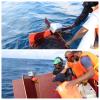|
Posted: 23 August 2018
 A new understanding of the timing and development of strong El Niño events has resulted from recent research by scientists at the National Oceanography Centre (NOC). This pioneering work was enabled...
A new understanding of the timing and development of strong El Niño events has resulted from recent research by scientists at the National Oceanography Centre (NOC). This pioneering work was enabled... |
|
Posted: 23 August 2018
 A new decision-making tool to help the energy sector plan effectively for the future and mitigate the consequences of flooding and rising sea levels on their coastal facilities has been developed by...
A new decision-making tool to help the energy sector plan effectively for the future and mitigate the consequences of flooding and rising sea levels on their coastal facilities has been developed by... |
|
Posted: 23 August 2018
 Why the Galapagos is special
The Galapagos is fascinating to everyone, famous for its association with Darwin’s evolutionary theory and amazing for marine scientists with its mixture of cold and...
Why the Galapagos is special
The Galapagos is fascinating to everyone, famous for its association with Darwin’s evolutionary theory and amazing for marine scientists with its mixture of cold and... |
|
Posted: 22 August 2018
 A new study led by the National Oceanography Centre (NOC) and the University of Southampton has revealed a series of depressions forming mysterious “tracks” on the seafloor, which may be an...
A new study led by the National Oceanography Centre (NOC) and the University of Southampton has revealed a series of depressions forming mysterious “tracks” on the seafloor, which may be an... |
|
Posted: 17 August 2018
 The third International Marine Science Communication Conference, CommOCEAN 2018, is being hosted by the NOC, this December in Southampton.
On 4 and 5 December 2018 the European Marine Board...
The third International Marine Science Communication Conference, CommOCEAN 2018, is being hosted by the NOC, this December in Southampton.
On 4 and 5 December 2018 the European Marine Board... |
|
Posted: 17 August 2018
 Structures in the ocean made by people, such as oil and gas rigs, shipwrecks or renewable energy devices, could help protect sea creatures under threat from human pressure and climate change,...
Structures in the ocean made by people, such as oil and gas rigs, shipwrecks or renewable energy devices, could help protect sea creatures under threat from human pressure and climate change,... |
|
Posted: 16 August 2018
 With changes in the northern North Atlantic being linked to the recent heatwave in Europe, the importance of diagnosing and predicting changes in this key region of the ocean is societally...
With changes in the northern North Atlantic being linked to the recent heatwave in Europe, the importance of diagnosing and predicting changes in this key region of the ocean is societally... |
|
Posted: 6 August 2018
 Details of a new open access database that enables the study of our planet’s changing biodiversity have just been published. The BioTIME database has almost nine million entries, from over half...
Details of a new open access database that enables the study of our planet’s changing biodiversity have just been published. The BioTIME database has almost nine million entries, from over half... |
|
Posted: 3 August 2018
 The first global GNSS-Reflectometry ocean wind data service has been launched by Surrey Satellite Technology Ltd (SSTL), in partnership with the National Oceanography Centre (NOC), and with support...
The first global GNSS-Reflectometry ocean wind data service has been launched by Surrey Satellite Technology Ltd (SSTL), in partnership with the National Oceanography Centre (NOC), and with support... |
|
Posted: 2 August 2018
 National Oceanography Centre scientists, Dr Matthew Palmer and Dr Gaby Mayorga-Adame, last month joined partners from the Zanzibar Institute for Marine Sciences (IMS) to undertake a drifter...
National Oceanography Centre scientists, Dr Matthew Palmer and Dr Gaby Mayorga-Adame, last month joined partners from the Zanzibar Institute for Marine Sciences (IMS) to undertake a drifter... |